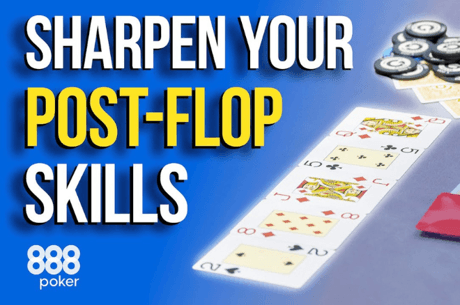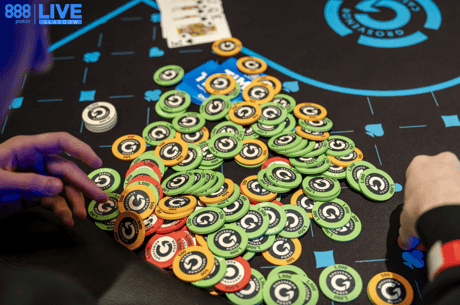10 Texas Hold'em Tips: Playing Suited Connectors

Many players just getting started with no-limit hold'em correctly find it worthwhile to be selective with their starting hands. Sticking mainly with pocket pairs, big and suited aces, and perhaps king-queen is not a bad way to begin. By restricting yourself to solid starters you give yourself a better chance of making better hands at showdown. You also tend to reduce somewhat the number of difficult decisions you end up facing per hand (though you can't eliminate them entirely).
Eventually, though, players realize they can't limit themselves to playing only the best starting hands. One reason why is because those hands don't come around that often, which means in a tournament (for example) the blinds and antes will start eating away at your stack as you keep folding hand after hand. Furthermore, by playing only top starting hands you become very easy to read, which means when you do finally pick up pocket aces or kings everyone is quick to fold when you raise, earning you only a small pot.
One way to open up your starting hand requirements is to add suited connectors to the hands with which you're willing to see flops. Suited connectors refer to two cards of the same suit that are consecutive in rank, such as J♠10♠ or 8♥7♥. Adding these hands can produce a number of benefits to your overall game.
Consider Position, Stack Sizes
Like any poker hand, suited connectors are best played when you have position on your opponent — that is, when you are acting last on each postflop round. If folded to in late position (say the cutoff or button), you might open with a raise holding 9♠8♠ and either win the blinds and antes or set up a situation in which you get to play from position versus a caller in the blinds.
Open-raising with suited connectors provides an added benefit of disguising your hand, as opponents will tend to think your raise indicates big-card hands. That means when you raise with 9♠8♠ and the flop comes 7♦6♣5♠, your opponent will tend to think you've missed when in fact you've hit it about as hard as you can.
You can also call raises from late position with your suited connectors, or even call from the blinds and play the hand from out of position. A big benefit of playing a hand like 7♦6♦ versus a preflop raiser is that if you do manage to make a straight or flush, you can win a big pot versus an opponent holding an overpair like aces, kings, or queens.
Suited connectors are essentially drawing hands — that is, they need to improve in order to win at showdown, and in most cases what you're drawing to will be either a flush or straight. (In some rare instances you'll make two pair or trips with suited connectors, but that isn't necessarily what you're hoping for when playing them.) The fact that you'll often be drawing — say, after flopping a straight draw — makes it even more advantageous to have position on your opponent, because you can either just call bets or check behind, deciding for yourself how much you are willing to commit when chasing your draw.
Besides position, you'll want also to be mindful of stack sizes when playing suited connectors. Ideally, you're hoping to win a big pot with them, and so it isn't worth calling a raise if you or your is short-stacked and you can only win so much should you make a big hand. Especially in tournaments, if you're short you probably shouldn't be calling big raises or shoving yourself with medium suited connectors like 8♣7♣ or 9♥8♥ (if you can afford to wait for higher-card hands, that is).
Similarly, it's not a good strategy to call raises with suited connectors if doing so eats too much into your stack. The idea most of the time with suited connectors is going to be to try to see a flop cheaply in order to win big — low risk, high reward.
Postflop Plays: Bluffing, Semi-Bluffing, and Folding
Having gotten to the flop with your 10♣9♣ or 6♦5♦ without investing too much to get there, if you miss the flop entirely, don't feel bad about letting your hand go when your opponent continuation bets. Or if you were the one raising preflop, it's okay to abandon ship if the flop is bad for your hand. If you sense your opponent might fold to a continuation bet, by all means go ahead and bluff and take the chips being offered to you. But don't get stubborn with 7♣6♣ on a K♦J♦3♠ flop — there are going to be much better spots for you later, you can count on it.
Sometimes, though, you'll either flop that draw or something that could become a draw by the turn, and in those cases you may well want to bluff with your suited connectors. This would actually be a semi-bluff, because even if your bet gets called, you can still improve and potentially win the hand.
Say you watch a player raise from middle position, you call from the button with 8♦7♦, and the big blind calls as well. The flop comes K♠9♥6♦, and the action checks around to you. Checking behind is fine — it's nice that they've give you a free card to chase your straight. Or you could bet as a semi-bluff here, potentially winning the hand without having to make your straight. Even if called, your opponent(s) may well check the next street and give you a free card on the turn, expecting you to bet again.
Think about what happens next when (for example) you do end up making a straight and winning a pot at showdown. Consider what that will do for your image going forward. Players will (1) see you were willing to play eight-seven, and (2) note that you bet the flop without having made a hand. Going forward, you might next bet with a strong hand and get action from players remembering you're the type who doesn't have to have a hand in order to bet.
Calculate your poker odds FOR FREE with the PokerNews odds calculator!
Open Your Starting Hand Selection, Open Your Mind
Whether you're playing online poker or live, adding suited connectors to those premium starting hands you prefer to play not only can help your image, making you no longer seem like a tight rock who only plays big hands and only bets when you have a lock on hands. Doing so also helps you start thinking about no-limit hold'em in a different way — you aren't just opening up your "range" of playable hands, but opening up your mind, too, to different aspects of the game.
Players who only bet when they are assured of having the best hand and fold when they don't are sometimes referred to as following a "fit-or-fold" strategy. Playing "fit-or-fold" poker isn't necessarily a bad thing when first starting out, and in fact in some very loose games full of lesser-skilled players it might be the best way to come away a winner. But if you want to advance in your game, you need to learn how to incorporate a few less straightforward plays, including the occasional check-raises, bluffs, and semi-bluffs.
Playing suited connectors will enable you to do just that — to make some plays (like semi-bluffs) that go beyond basic bet-when-you-have-it, fold-when-you-don't poker. It will also get you involved more often and expose you to different situations and postflop problems, giving you more valuable experience as you further improve your game.
Also in this series...
- The Check-Raise
- The Fundamentals of Set Mining
- Pot Odds Basics
- Bluff Catching
- Slow Playing Do's and Don'ts
- Calculating Your Win Rate
- The Importance of Position
- 5 Common Poker Tells to Look For
- Bet Sizing
Best Poker Sites to Test Playing Suited Connectors in Texas Hold'em
Playing Suited Connectors in Texas Hold'em FAQs
What are suited connectors in Texas Hold'em?
Suited connectors are two consecutive cards of the same suit. For example, 5♥ 6♥ or J♠ 10♠. These hands have the potential to make straights and flushes, making them interesting starting hands.
When should I play suited connectors?
Playing suited connectors is often recommended in late position or when the blinds are low. These hands play well in multi-way pots and can be profitable if you can see the flop without investing too many chips. Be cautious when playing them from early positions, as it can be more challenging to build a pot.
What's the primary goal when playing suited connectors?
The primary goal when playing suited connectors is to hit a strong draw or a made hand on the flop. Suited connectors are usually not strong enough to play for high pots pre-flop, but they can become valuable if you make a straight or a flush on the flop, turn, or river.
How should I play suited connectors after the flop?
After the flop, the way you play suited connectors depends on the strength of your hand and the community cards. If you've hit a strong draw, like an open-ended straight draw or a flush draw, it's often a good idea to be aggressive and build the pot. However, if the flop doesn't improve your hand, consider folding unless you have a good read on your opponents or specific reasons to continue.
What are the common mistakes to avoid when playing suited connectors?
When playing suited connectors, common mistakes to avoid include:
- Overvaluing these hands pre-flop and investing too many chips.
- Playing them too aggressively without considering your position and the table dynamics.
- Chasing draws relentlessly without considering pot odds and implied odds.
- Failing to fold when it's clear that your hand is unlikely to improve.
Article last updated 20 Oct 2023.










